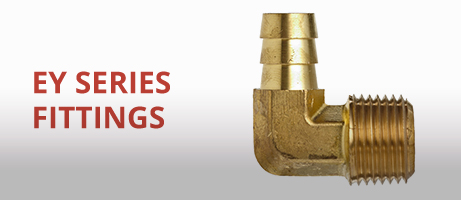EY SERIES • FITTINGS

SEALING FITTINGS
Class I, Div. 1 & 2, Groups A,B,C,D
Class I, Zone 1, Groups IIC, IIB, IIA
Class II, Div. 1 & 2, Groups E,F,G
Class III
FEATURES-SPECIFICATIONS
Application & Installation
Class I, Divisions 1 and 2
The purpose of seals in a Class I hazardous location is to minimize the passage of gases and vapors and prevent the passage of flames from one electrical installation to another through the conduit system. Seals are required to be installed within 18 inches on any conduit run entering an enclosure which contains devices that may produce arcs, sparks, or high temperature. Where two enclosures are connected by a run of conduit not over 3 ft. long, a single seal located at the center of the run is considered satisfactory. Only explosionproof unions, couplings, elbows, and conduit bodies similar to “L”, “T”, and “X” type shall be permitted between the sealing fitting and the enclosure. Seals shall be located within 18 inches of the enclosure or fitting on each conduit run of 2 inch size or larger entering an enclosure or fitting that contains terminals, splices, or taps. Each run of conduit from a hazardous location to a nonhazardous location should be sealed to minimize the amount of gases and vapors communicated beyond the seal.
Class II, Divisions 1 and 2
Where a raceway provides communication between an enclosure which is required to be dust-ignitionproof and one which is not, suitable means shall be provided to prevent the entrance of dust into the dust-ignitionproof enclosure through the raceway.
Considerations for selection seals:
Select the proper sealing fitting for the hazardous gas/vapor involved; i.e., Class I Groups A, B, C, or D. Zone 1, Groups IIC, IIB, IIC
Select a sealing fitting for the proper use in respect to mounting position. This is particularly critical when the conduit runs between hazardous and nonhazardous areas. Some seals are designed to be mounted in any position; others are restricted to vertical mounting.
Drains
Where there is a probability that liquid or other condensed vapor may be trapped within enclosures for control equipment or at any point in the raceway system, approved means — such as installation of drain seals — shall be provided to prevent moisture accumulation. For more complete data or special applications, consult the code or your local inspector. Sealing compounds shall be approved for the purpose and shall not be affected by the surrounding atmosphere or liquids, and shall not have a melting point of less than 93°C. (200°F.). In the complete seal, the minimum thickness of the sealing compound shall not be less than the trade size
of the conduit, and in no case less than 5/8 inch.
Note: The amount of Killark sealing compound and packing fiber required for any seal is determined by volume hub size and mounting position of the seal. Refer to installation data table on page F50 for specific amounts required.
Splices and taps shall not be made in fittings intended only for sealing with compound, nor shall other fittings in which splices or taps are made be filled with compound. Killark sealing fittings are produced with utmost care to insure a substantial margin of safety. Threads are clean, deep, and snug. When properly installed with Killark sealing compound (SC Type) and Killark non-asbestos fiber (PF Type) for the dams, you can be sure your installation will provide more than adequate safety.





